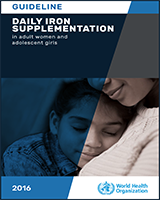ANNEX 2SUMMARY OF THE CONSIDERATIONS OF THE MEMBERS OF THE GUIDELINE DEVELOPMENT GROUP FOR DETERMINING THE STRENGTH OF THE RECOMMENDATION FOR DAILY ORAL IRON SUPPLEMENTATION IN MENSTRUATING ADULT WOMEN AND ADOLESCENT GIRLS
View in own window
| QUALITY OF EVIDENCE: | Anaemia and iron deficiency had moderate-quality evidence. The effect sizes of the intervention on these outcomes were large. The quality of the evidence for the effect on haemoglobin is high though there is currently no evidence on the outcome of iron deficiency anaemia. Although the evidence of either loose or hard stools is of high quality, the quality of the evidence for adverse effects or gastrointestinal effects in general is low or very low. |
|---|
| VALUES AND PREFERENCES: | Adherence may be a concern. If the intervention is perceived as non-essential, there may be little demand for it.
Where access to health facilities is limited, as in many rural areas, the problem may be more prevalent. Inequities in access may thus negatively affect successful implementation. |
|---|
| TRADE-OFF BETWEEN BENEFITS AND HARMS: | Benefits include improved haemoglobin and lower risk of anaemia or iron deficiency, which have functional consequences such as improved exercise performance. Potential harms include gastrointestinal effects, but evidence is of low quality. There is increased risk of either diarrhoea or constipation, with high quality of evidence.
Not enough data are available on adverse events, or long-term harm, for instance on overdose, specifically for those who are iron replete. |
|---|
| COSTS AND FEASIBILITY: | The cost will largely be determined by the operational challenges rather than the cost of the supplementation itself. The difficulty will lie in attempting to set up vertical programmes, which can prove very costly. Health services that do not have preventive health care in menstruating adult women and adolescent girls may be more likely to find this intervention infeasible. |
|---|

